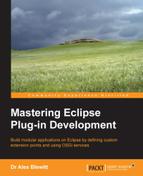Book Description
Build modular applications on Eclipse by defining custom extension points and using OSGi services
In Detail
Mastering Eclipse Plug-in Development shows you how to build an extensible application using custom extension points and dynamic OSGi services in Eclipse. Dynamic design patterns such as whiteboard and extender are covered along with specific techniques to deal with native and legacy code.
This book dives right into the details and teaches you how to define new JFace wizards and extend Eclipse with custom extension points. Then the book moves quickly on to the details of how to define new commands for the Eclipse console and how to include native code in a plug-in. You will engage with modular application design patterns and Thread Context ClassLoaders before getting the details on how to create as well as manage P2 sites and write help documentation for an Eclipse plug-in.
What You Will Learn
- Create a custom extension point to allow other plug-ins to contribute
- Employ Declarative Services and Blueprint for dynamic OSGi contributions
- Extend the Common Navigator Framework to provide nested content
- Build commands to extend the built-in Gogo shell
- Use fragments to contribute native code to plug-ins
- Fix code using the service loader and wrap non-OSGi-friendly JARs
- Discover how to build modular applications with decoupled design patterns
Downloading the example code for this book. You can download the example code files for all Packt books you have purchased from your account at http://www.PacktPub.com. If you purchased this book elsewhere, you can visit http://www.PacktPub.com/support and register to have the files e-mailed directly to you.
Table of Contents
- Mastering Eclipse Plug-in Development
- Table of Contents
- Mastering Eclipse Plug-in Development
- Credits
- About the Author
- Acknowledgments
- About the Reviewers
- www.PacktPub.com
- Preface
- 1. Plugging in to JFace and the Common Navigator Framework
- 2. Creating Custom Extension Points
- Extensions and extension points
- Creating an extension point
- Creating an IFeedParser interface
- Creating a MockFeedParser class
- Creating the extension point schema
- Using the extension point
- Integrating the extension with the content and label providers
- Showing a feed in the browser
- Implementing a real feed parser
- Adding support for Atom
- Making the parser namespace aware
- Priority and ordering
- Executable extensions and data
- Executable extension factories
- Using the extension registry outside of OSGi
- Creating an extension point
- Summary
- Extensions and extension points
- 3. Using OSGi Services to Dynamically Wire Applications
- Overview of services
- Registering a service programmatically
- Registering a service declaratively
- Dynamic services
- Dynamic Service Configuration
- Summary
- 4. Using the Gogo Shell and Commands
- Consoles in Equinox
- Extending the shell
- Summary
- 5. Native Code and Fragment Bundles
- 6. Understanding ClassLoaders
- 7. Designing Modular Applications
- Semantic versioning
- Public APIs and version ranges
- Baselining and automatic versioning
- Design patterns
- Best practices
- Separate API and implementation
- Decouple packages
- Decouple services
- Prefer Import-Package to Require-Bundle
- Version packages and bundles
- Avoid split packages
- Import and export packages
- Avoid start ordering requirements
- Avoid long Activator start methods
- Use configuration admin for configuration
- Share services, not implementation
- Loosely coupled and highly cohesive
- Compile with the lowest level execution environment
- Avoid Class.forName
- Avoid DynamicImport-Package
- Avoid BundleActivator
- Consider thread safety
- Test in different frameworks
- Summary
- 8. Event-driven Applications with EventAdmin
- 9. Deploying and Updating with P2
- 10. User Assistance in Eclipse
- Index
